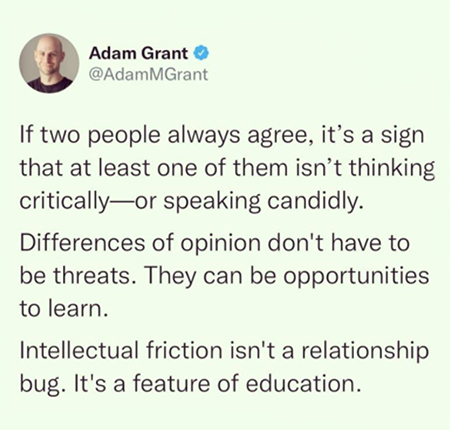
Conflict doesn't have to mean not being able to work together. It can be an opportunity to learn and grow.
Poor managers. And I’m not rolling my eyes as I type this—I truly believe managers have a tough job in leading people.
One of the toughest things they have to do is leading their team members through conflict. Most are not particularly good at it. After all, they don’t even like giving negative feedback.
Conflict is so much worse. Yet seldom do conflicts ever just go away. Ignoring them won’t do the trick. Rather, they must be faced, head-on, and dealt with. Ugh…
Raise your hand—do you like dealing with conflict? Nope? Not a surprise. But managers can’t fear conflict. Why? Because it’s a fact of life at work.
Conflict doesn’t always present itself as a big fight or blow-up between team members. Let’s look at what conflict is, and then we can start on how to deal with it.
Conflict is a difference of opinion, pushback, or disagreement. These things are inherent in management functions such as:
- Employee evaluations
- Budgeting and resource allocation
- Scheduling
- Task allocation (i.e. who does what and why they were chosen)
- Accountability
- Feedback and corrective action
Think about managing around any of these managerial tasks and you’ll see conflict could occur in any one of them. Even so, managers can’t avoid these tasks; they’re just part of life at work.
The ability to successfully resolve conflict depends on your ability to:
- Manage stress quickly while remaining alert and calm. By staying calm, you can accurately read and interpret verbal and nonverbal communication.
- Control your emotions and behavior. When you’re in control of your emotions, you can communicate your needs without threatening, intimidating, or punishing others.
- Pay attention to the feelings being expressed as well as the spoken words of others.
- Be aware of and respect differences. By avoiding disrespectful words and actions, you can almost always resolve a problem faster.
All of that involves a LOT of EQ (Emotional Intelligence). Managers must be able to manage their own feelings, but also understand the feelings of others, or at least try to. This begins with being aware of their own emotions. Managers who react without thinking first risk escalating conflicts into areas they really don’t want to head into. By being calm and focused, and staying in control of emotions and reactive behaviour, managers will be able to better communicate in a way that leads to resolution, versus escalation.
Once they have a really clear picture of what is truly important to the person or people involved, managers can then use that information to form strategy for interesting and influencing others to hear their ideas. EQ is not about giving others everything they want. Sometimes that’s not what’s best for an organization or team, or even the individual. EQ is about hearing and understanding them, and then about doing what’s best. Bear in mind, this may mean doing what they propose and not what the manager originally thought was best. Hence this idea of being open and aware of feelings, and respecting differences in opinion.

Okay, that’s the prework. Managers must first get control of their own emotions before working with others to find the solution to the conflict. Now let’s look at how to address the conflict itself.
Here are some great tips for managing conflict and driving toward resolution (Source: Clarke University):
- Accept conflict. Conflict is a natural part of life, never mind business. It happens in every relationship and offers us an opportunity to grow, reach new understandings, and improve communication.
- Be a calming agent. Your response to conflict can make it better… or worse. Therefore, be calm. Provide an objective or neutral view when working with others in conflict. Plan how you will work with the other party (parties) to reach a resolution.
- Use your active listening skills. Pay attention and really focus on the other party. What are they telling you? How do they feel? What is the impact of actions taken? What would they like to come out of it?
- Analyze the conflict. Clarify what the specific problem is. Ask about what triggered it and what is causing anger or confusion. Dig into key issues and really listen to what is being said.
- Watch your language. This doesn’t necessarily mean profane language—although that might apply—but also refers to accusations, name calling, and exaggerations that make things worse. Rather than sinking into this type of dialogue, state what you need to state in a more objective way that communicates information useful for future discussions.
- Focus on the problem, not the person. Viewing the problem as a specific set of circumstances will help to avoid the accusatory language mentioned above. This approach can also help to manage the problem and reduce feelings of “not being able to stand that person any longer”.
- Move away from blame and toward working together. Each person must take ownership of their share of the problem. Making commitments to working together and listening to each other can help to solve the conflict.
- Accept differing points of view. Demanding “the truth” or one right way can lead to ongoing battles. Truth is relative to the individual’s point of view. Rarely do people agree on every single detail.
- Share your WHY. Sharing interests and whys behind each party’s position can lead to working together to find common solutions that satisfy those interests.
- Be creative. Sometimes finding a resolution means being creative and thinking beyond what is usual. Be careful not to just give in. After all, agreements reached too quickly usually don’t last and might lead to resentment. Also avoid the “my way or the highway” approach that managers so often employ, unless it’s truly the last resort. Do some brainstorming to come up with creative solutions that will work for everyone, including the company.
- Be specific. Clarify anything that is ambiguous and subject to interpretation. You want everyone on the same page.
- Create a plan for the future. Don’t dwell on what has happened in the past. Be future-focused and create a plan to address this specific conflict and others that could arise in the future.
And here are some more ideas taken from an amazing TED talk given by Nadia Lopez, who is a middle school principal in Brooklyn – one of the most violent neighbourhoods in New York. It’s a short talk and well worth a listen.
These are her ways to dial down conflict:
- Be vulnerable. Being open and honest with your team or the person you’re in conflict with demonstrates you are open and trustworthy. Sharing where you struggle fosters a sense of understanding and support. This is far more impressive than pretending you’re a fearless, all-knowing manager and your way is the only way.
- Be aware. Stop and ask yourself why your idea isn’t working. Face to face conversations are important here. This isn’t something to handle via email or Slack. Hold yourself accountable to do what it takes to move forward.
- Center yourself. Leaders deal with challenges from all sides. It’s important to be a calm and rational mediator. Writing things down and/or taking time to reflect before acting helps put things into perspective and can help you decide if something is worth the fight.
- Manage mediation. If you’re put into the role of managing the conflict, lay out what you expect from others in the conflict i.e. protocols and rules of engagement. Create a safe space for open and honest communication. View the problem as a specific set of circumstances.
- Listen deeply and actively. It’s really important to acknowledge the feelings of others. Show that they’ve been heard by using active and reflective language. Be compassionate and empathetic.
- Acknowledge, respect, thank, repeat. Thank the people involved for their willingness to work things out. Acknowledge their part in the resolution and show how much you respect their contributions. Recognizing a person’s dedication and skills in the conflict calms troubled waters.
Finally, understand managers need help with all aspects of managing people—including conflict. Support the soft skills development of your people leadership team with training and coaching. There are lots of resources available, and we’re happy to help.